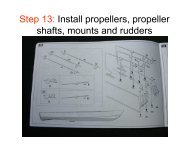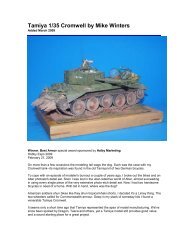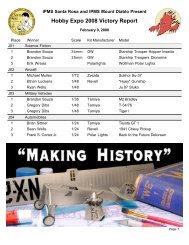Douglas X-3 Stilleto Walkaround - IPMS Santa Rosa
Douglas X-3 Stilleto Walkaround - IPMS Santa Rosa
Douglas X-3 Stilleto Walkaround - IPMS Santa Rosa
Create successful ePaper yourself
Turn your PDF publications into a flip-book with our unique Google optimized e-Paper software.
<strong>Douglas</strong> X-3 <strong>Stilleto</strong> <strong>Walkaround</strong>This walkaround was inspired by our Expo 2003 Contest Theme, "Fabulous Failures". Ifany aircraft evokes the adjective, "Fabulous", it is the <strong>Douglas</strong> X-3 Stiletto. Its needlelikeshape and diminutive wings were the ultimate embodiment of streamlining andspeed, at least by the aerodynamic principles of the late 1940s.The X-1 and X-2 opened the door to supersonic flight, but both were rocket powered withvery limited flight duration and used a drop-ship for launch. The X-3 was to be poweredby twin turbojets and have an endurance of 10 minutes at Mach 2. Unfortunately, theengines proved to be woefully short of their promised thrust and that rapier profile didnot slice through the sound barrier, but rather contributed enormous surface drag. Afterthe first flight in 1952, it was clear that the X-3 was a "ground hog". Takeoff speed was260 mph and the highest speed ever achieved was Mach 1.21, in a 30-degree power dive!Some flight-testing was conducted to investigate the flight charteristics of those stubbywings and the phenomenon of roll coupling, but as a vehicle for "pushing the envelope",it was a complete dud. The order for a second aircraft was canelled and the sole Stilettowas quietly put to pasture at the Air Force Museum in 1956.These photos were taken in 1981. While the AFM has one of the premier aircraftcollections in the world, it also has the worst lighting of any museum I have visited. Theblack painted interior of the cavernous main "hanger" and the dark concrete floor soak upstobe light like outer space while the supended spotlights casting glare on the exhibits arelandmines for light meters. Overall, I'm pretty happy with way most of these shotscleaned up in Photoshop, but there are a couple where the harsh lighting adds a bizzareaura to an already strange aircraft.
• Image 2: Althought the photo isn't all that clear, you can clearly see that the "X-3" logo hasa black shadow on the lower and right edges.• Image 4: This is the leading edge of the wing. The X-3 Wing featured a movable leadingedge to increase the camber of the airfoil for low airspeed flight. The fairings under the winghouse the actuators. (The mass balance seen in the background is part of a neighboringexhibit.)• Image 5: No, this is not a negative. Like a stealth fighter, the oblique surfaces of the X-3when seen from this view, reflected very little strobe light back to the camera. Only theintakes, edges of the gear doors and sheet metal joints reflected brightly, creating this ghostlyimage.• Image 6: You can catch a glimps of the compressor blades behind the intake duct. TheXJ34-WE-19 had eleven compressor stages. Also, notice that there is no canopy - onlywindscreen. How did the pilot get in? Through a hatch in the cockpit floor!• Image 10: Notice the fuel injectors and flame holders for the afterburner. More modernengines feature variable geometry exhaust nozzles (so called "turkey feathers") to furtheraccelerate the exhaust gas and increase thrust.
• Image 16: The nose gear well and door are painted aluminum.• Image 18: Left side, looking aft. The doors and well interior are mostly aluminum paint.• Image 19: Right side, looking forward. The forward bulkhead is yellow chromate, theelectrical boxes are black.• Image 20: Most of the airframe and instrument panel surfaces are medium grey. The seatframe is a little lighter grey. The cockpit floor hatch is green chromate. The instrument bezelsare black. Throttle knobs are white. Gear retraction knob is black. That big "facet" handle inthe forground appears to be silver. Assorted switch covers are red..
There are two other online photo collection taken at the AFM, which include some nicecolor photos of the cockpit (it wasn't lighted when I was there!). One, taken by SvenKnudson, can be found at his Ninfinger Scale Models website.Another by Garfield Ingram can be found on Hyper Scale.Models of the <strong>Douglas</strong> X-3 StilettoIn addition to being a "Fabulous Failure", most models of the Stiletto also qualify for the"Sow's Ear" Award. I wouldn't be surprised if the original 1/64 scale Revell kit was acontemporary of the actual aircraft, making it about 50 years old. It is currently out ofproduction, but was reissued several times and is not terribly rare. A review by Scott VanAken can be found on Modeling Madness.Only slighty better, but in a standard scale, is the 1/48 Lindberg kit. Incredibly, it is inthe current catalog. A review by Caz Dalton can also be found on Modeling Madness.Project-X Vacuforms issued an X-3 in 1/72. It's pretty basic. Photos of one built byMeindert can be found on his website, Aircraft Modelling In Plastic.Your best bet however, is a 1/72 resin kit issued by Planet Models. A review by SvenKnudson can be found on his Ninfinger Scale Models website.Happy modeling! - Greg










